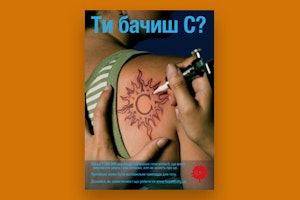Designing for Essential Medicine
By Jen Matsumoto

As a graduate student in the Design and Technology program of Parsons The New School for Design, I had the opportunity to apply my education and skills to the struggle for global health. The Open Societies Foundations and Parsons granted me a fellowship to spend the summer working with Universities Allied for Essential Medicines (UAEM), supporting their efforts through a range of design work. After the summer, I continued the work begun during me fellowship by acting as a teaching assistant in the Inventing Open Societies studio class at Parsons this fall. Both the fellowship and class are part of an ongoing partnership that pairs design students with global development issues like health.
For my summer fellowship, I worked closely with UAEM Executive Director Bryan Collinsworth in New York City. My weekly meetings and continuous communication with Bryan allowed me to quickly familiarize myself with the complicated issue of essential medicines, and with UAEM’s mission, audience, and goals. My task was to help with the visual design of one of UAEM’s prime initiatives, the Global Health Report Card project. The project seeks to grade the top 60 medical research universities in the United States and Canada, thereby shaming the respective universities into positive action. I worked on a logo and color scheme, and did a series of layouts to gauge what UAEM would want. Both UAEM and I were happy with the results, and the website is currently in production.
Out of this experience, we saw a need to better articulate UAEM’s issues and goals. These can be difficult to comprehend, so I felt it was crucial to develop a visual mechanism to support this kind of communication. Employing a series of key facts from Bryan, I created a set of infographics for the Report Card website that can be used by the universities themselves to clarify and emphasize their work.
Returning for the fall semester of Inventing Open Societies, the class combined the work of three summer fellows and their NGOs into a collaborative project in which we would conceive and prototype an innovative tool to support UAEM’s daily work. We determined that UAEM needed better communication, transparency, and lasting institutional memory. Because UAEM is a student-based organization, the cycle of graduations presents continuity problems. We developed a concept for a web platform that supports communication and workflow within UAEM’s chapters, provides visibility into the activities and process of other chapters around the world, and creates a living archive of the organization’s work even as members come and go. I was fortunate to share the prototype at the UAEM Fall 2012 Conference in Irvine, California where it was met with an overwhelmingly positive response from the community. It was gratifying to see the excitement and hard work of UAEM’s dedicated students, and to be able to support their work with our own. We finished the semester with a completed prototype of the platform—uaem.org/social.
Working with UAEM from fellowship through the fall semester has been extremely fulfilling and eye-opening. Throughout this process I have been continuously inspired by the people I’ve met and collaborated with. From the summer work with the report card, to the social web platform, we supported UAEM with innovative new tools to develop their work in new and important ways.
Jen Masumoto is a student of the Parsons The New School for Design
